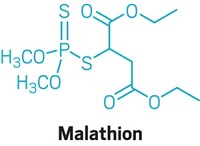Advertisement
Grab your lab coat. Let's get started
Welcome!
Welcome!
Create an account below to get 6 C&EN articles per month, receive newsletters and more - all free.
It seems this is your first time logging in online. Please enter the following information to continue.
As an ACS member you automatically get access to this site. All we need is few more details to create your reading experience.
Not you? Sign in with a different account.
Not you? Sign in with a different account.
ERROR 1
ERROR 1
ERROR 2
ERROR 2
ERROR 2
ERROR 2
ERROR 2
Password and Confirm password must match.
If you have an ACS member number, please enter it here so we can link this account to your membership. (optional)
ERROR 2
ACS values your privacy. By submitting your information, you are gaining access to C&EN and subscribing to our weekly newsletter. We use the information you provide to make your reading experience better, and we will never sell your data to third party members.
Pesticides
US EPA to impose atrazine restrictions
Proposal would reverse the Trump administration’s weaker standard
by Britt E. Erickson
July 1, 2022

The US Environmental Protection Agency is proposing new mitigation measures to protect aquatic environments from the widely used herbicide atrazine. If finalized, the measures would reverse a 2020 policy decision implemented by the Trump administration that loosened restrictions for growers near rivers and streams.
Under the EPA’s proposal, growers located in watersheds with atrazine concentrations that exceed 3.4 μg/L would have to reduce runoff or reduce their application rates. That level is far lower than the 15 μg/L threshold adopted by the Trump administration.
The EPA determined the 3.4 μg/L level of concern in a 2016 ecological risk assessment. When the concentration is exceeded, atrazine has a 50% chance of negatively impacting aquatic plants.
In addition to the lower threshold, the EPA proposes prohibiting all growers from using atrazine when soils are saturated with water, during rain, or when storms are forecasted within 48 hours. All growers would also be prohibited from aerial spraying of atrazine.
Farm groups are disappointed in the EPA’s decision. The National Corn Growers Association claims the proposed requirements would limit how much atrazine farmers can use and “impose arduous new restrictions and mitigation measures on the herbicide.”
Atrazine is widely used on corn and other crops to control grass and broadleaf weeds. It is also used on residential lawns. The herbicide is banned in the European Union because of concerns over its developmental and reproductive toxicity.
Environmental groups, which challenged the EPA’s 2020 atrazine decision, welcome the proposal. But they are urging the EPA to go a step further and ban the herbicide. “It’s great to see the EPA reverse the Trump administration’s egregious plan to allow a 50% increase in the amount of atrazine allowed in our rivers and streams,” Nathan Donley, environmental health science director at the Center for Biological Diversity, says in a statement. “But the best independent science leaves no doubt that any amount of atrazine in the water is too much. We’re far past the point where we can rely on half-measures to protect our most imperiled species from endocrine disruptors like atrazine.”





Join the conversation
Contact the reporter
Submit a Letter to the Editor for publication
Engage with us on Twitter